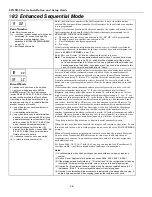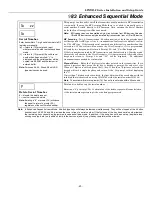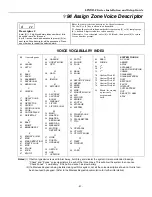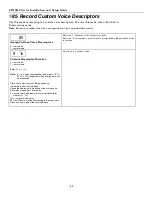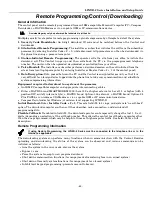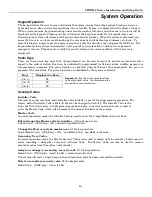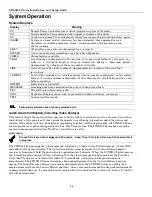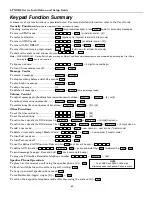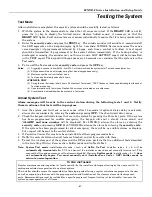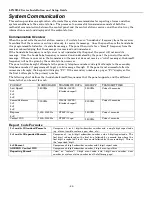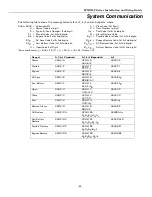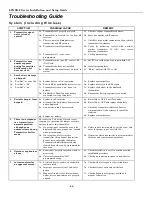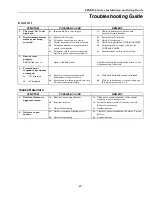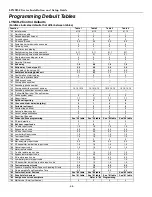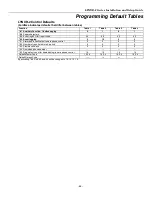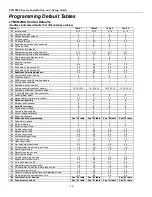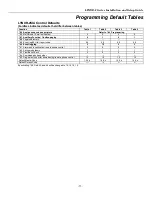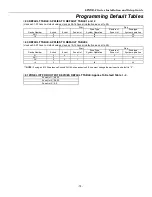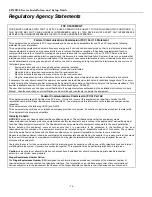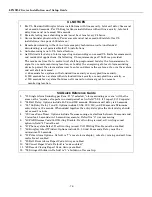
LYNXR-2 Series Installation and Setup Guide
- 61 -
Testing the System
Test Mode
After installation is completed, the security system should be carefully tested, as follows.
1. With the system in the disarmed state, check that all zones are intact. If the
READY
LED is not lit,
press the [
✻
] key to display the faulted zone(s). Restore faulted zone(s), if necessary, so that the
READY
LED lights. Fault and restore every sensor individually to assure that it is being monitored by
the system.
2. Enter
the
security code
and press the
TEST
key. The outside sounder will sound for 1 second and all
the LED segments on the keypad display light for 3 seconds. LYNXR-2 Series announces the zone’s
voice descriptor (if programmed) followed by 3 beeps, each time a contact is faulted. A test report
should be transmitted (if programmed) to the central station immediately. If the backup battery is
discharged or missing, the sounder may not turn on and a LOW BATTERY report will be transmitted
with a TEST report. The keypad will beep once every 45 seconds as a reminder that the system is in the
Test mode.
3. To turn off the Test mode enter
security
code
and press the
OFF
key.
Notes:
(1) Triggering a zone set to Arm AWAY, Arm STAY, or Disarm will take the system out of Test and cause that action.
(2) BR type transmitters do not display during Test mode (keypad beeps only)
(3) Macros cannot be run from the Test mode.
(4) Test mode automatically ends after 4 hours.
LYNXR-2SIA
ONLY
(5) During the final 5 minutes (after 3 hours 55 minutes of Test mode), “TEST” flashes on the keypad indicating that the end of
Test mode is nearing.
(5) Upon termination of a test mode all faulted 24-hour zones are treated as a trouble zones.
(6) Fire verification is disabled when the system is in Test mode.
Armed System Test
Alarm messages will be sent to the central station during the following tests 1 and 2. Notify
them in advance that tests will be in progress.
1. Arm the system and fault one or more zones. After 15 seconds (if optional dialer delay is selected),
silence alarm sounder(s) by entering the
code
and pressing
OFF.
Check entry/exit delay zones.
2. Check the keypad-initiated alarms that are in the system by pressing the Panic key pairs. If the system
has been programmed for audible emergency, the keypad will emit a steady alarm sound, and
“
ALARM”
and zone number
will be displayed. For LYNXR-2, silence the alarm by entering the
security code
and pressing
OFF.
For LYNXR-2SIA, silence the alarm by entering the
security code.
If the system has been programmed for silent emergency, there will be no audible alarms or displays,
but a report will be sent to the central station.
3. If Powerline Carrier Devices have been installed, test their programmed action.
4. Notify the central station when all tests are finished, and verify results with them.
5. To test the wireless part of the system and the RF receiver, perform the two additional tests described
in the
Installing Wireless Zones
section: Sniffer mode and Go/No Go Test.
Note: System Test mode
(installer/master code + test) and
Go/No Go Test
(installer code + # + 8) will be
automatically terminated
after 3-1/2 to 4 hours if the installer or user does not manually terminate it. This
ensures that fire and panic zones will not remain disabled. However,
Sniffer mode
(installer code + # + 3)
does
not automatically expire
.
You must manually exit (Installer/User Code + OFF) Sniffer mode to
return to normal operation.
TO THE INSTALLER
Regular maintenance and inspection (at least annually) by the installer and frequent testing by the user are vital to
continuous satisfactory operation of any alarm system.
The installer should assume the responsibility of developing and offering a regular maintenance program to the user
as well as acquainting the user with the proper operation and limitations of the alarm system and its component
parts. Recommendations must be included for a specific program of frequent testing (at least weekly) to ensure the
system’s proper operation at all times.
Summary of Contents for LYNXR-2 Series Security System
Page 4: ... 4 ...
Page 78: ...LYNXR 2 Series Installation and Setup Guide 78 Notes ...
Page 79: ...LYNXR 2 Series Installation and Setup Guide 79 Notes ...
Page 80: ...LYNXR 2 Series Installation and Setup Guide 80 Notes ...
Page 81: ...LYNXR 2 Series Installation and Setup Guide 81 Notes ...
Page 82: ...LYNXR 2 Series Installation and Setup Guide 82 Notes ...


